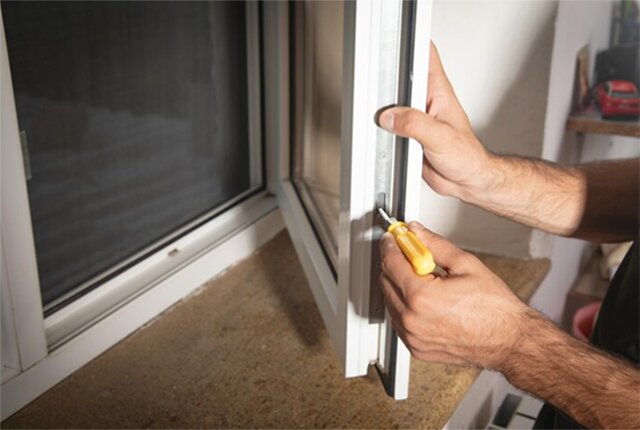Installing double hung windows in your home can be a great way to add light and style to any room. In order for the installation process to go smoothly, it is important that you review the included instructions and make sure you have all the necessary tools and materials.
Disclaimer: The information contained in this article is intended to be used as a general guide only. While we have attempted to be as thorough and accurate as possible, we suggest seeking the advice of professionals when it comes to installing double hung windows in your home. Advance Roofing LLC has years of experience providing top-notch roofing services in the Spokane, WA area and is always happy to help.
What are Double-Hung Windows?
Double-hung windows are popular types of windows that consist of two movable sashes that slide vertically up and down in a single frame. They are versatile, energy efficient, and cost-effective and are perfect for almost any home decor and style. When it comes to window replacement projects, double-hung windows are a popular choice among homeowners since they are easy to install and maintain. In this beginner’s guide, we’ll discuss everything you need to know about installing double-hung windows in your home.
Benefits of Installing Double-Hung Windows in Your Home

If you’re looking to upgrade your home’s windows, double-hung windows are an excellent choice. These windows have a traditional look, but they come with a range of benefits that make them a smart investment for any homeowner.
One of the main advantages of double-hung windows is their ventilation. Because both the top and bottom sashes can be opened, you’ll have greater control over the airflow in your home. During the warm summer months, you can open both sashes and enjoy a refreshing breeze. As temperatures drop, you can close the bottom sash and keep the top sash open to allow warm air to escape.
In addition to ventilation, double-hung windows are also highly energy efficient. Newer models often feature Low-E glass and insulated frames that can reduce the amount of heat loss from your home. This can help you save money on your energy bills over time.
Another benefit of double-hung windows is their easy-to-clean design. Many models have sashes that can tilt inwards, so you can clean both sides of the glass from inside your home. This is a big advantage over other types of windows that require you to clean the exterior from a ladder or hire a professional window cleaner.
Finally, double-hung windows come in a range of sizes to fit any space. Whether you need a small window for a bathroom or a larger window for a living room, you can find a double-hung window that meets your needs.
In summary, there are many benefits to installing double-hung windows in your home. They offer excellent ventilation, energy efficiency, easy cleaning, and a range of sizes to fit any space. By investing in double-hung windows, you can enjoy all these advantages and more.
Materials Needed for Installation
Before you get started with installing double-hung windows, it’s important to have all the necessary materials on hand. Here’s a list of items you’ll need to complete the installation process:
Tools Required for Installation

In order to install double-hung windows, you will need a variety of tools. It is important to gather all of these tools before you begin the installation process to ensure that the job goes smoothly. Here are some of the essential tools you will need:
- Hammer – Used for driving nails or screws into the wall.
- Pry bar – Used for removing the old window and for leverage when installing the new window.
- Saw – Used for cutting the window opening if required.
- Tape measure – Used to measure the size of the window opening. 5. Level – Used to ensure that the window is straight and level. 6. Drill – Used to make holes for the screws or nails.
- Screwdriver – Used to tighten screws or nails.
- Caulking gun – Used to apply caulk around the window frame.
It is important to have safety glasses and gloves on hand for added safety. In addition, a ladder may be required to reach higher areas. By gathering all of these tools before starting the installation process, you can ensure that the job is completed in a timely and efficient manner.
Supplies Needed for Installation

Before installing double-hung windows in your home, it’s essential to gather all necessary supplies to ensure a smooth installation process. Here are the supplies you’ll need:
- Caulk – This is used to seal any gaps between the window frame and the wall. Make sure to choose a caulk that is specifically made for windows and has good adhesive qualities.
- Fiberglass insulation – This is used to insulate the gap between the window frame and the wall, which will help to prevent drafts and reduce energy bills.
- Minimal expanding foam – If there are large gaps between the window frame and the wall, minimal expanding foam can be used to fill them in. Be careful not to overfill the gaps, as this can cause the window frame to warp.
- Shims – These are small wedges used to level the window within the opening and keep it secure. Wood shims are recommended as they provide better insulation than plastic ones.
- Pry bar and pliers – These tools are used to remove the old window, if necessary. It’s important to take caution when removing the old window and to follow safety guidelines.
Additionally, if your home was built before 1978, it’s important to test for lead paint before disturbing any surfaces. Use a do-it-yourself lead testing kit or get a lab analysis of paint chips to ensure your safety.
By having all the necessary supplies, you’ll be on your way to a successful installation of double-hung windows in your home.
Preparing the Window Opening
Before you can install double hung windows in your home, you need to make sure that the window openings are ready to receive the new windows. Preparing the window opening means ensuring that it’s the right size and shape, removing any obstructions, and making sure that the window frame is strong and secure. Whether you’re replacing old windows or installing new ones, it’s important to do the necessary prep work to ensure a smooth and successful window installation. Here’s a beginner’s guide to preparing your window openings for double hung windows.
Measuring the Window Opening
If you’re planning to install double-hung windows in your home, the first step is to measure the window opening accurately. Measuring the width and height of the window opening is vital to ensure a proper fit for your window.
To begin the process, you’ll need a measuring tape, a pencil, and a piece of paper to record your measurements.
Start by measuring the width of the window opening in at least three places: the top, middle, and bottom. Be sure to measure from inside the frame, from one side jamb to the other.
Record each dimension you measure, and then use the smallest one to ensure a snug fit for your window.
Next, measure the height of the opening in the same manner, taking measurements at three different points: left, center, and right. Again, take the smallest measurement to make sure the window fits properly.
It is essential to check if the window opening is square. To do this, measure the diagonals of the window opening from corner to corner. If both measurements are equal, the opening is square. If they differ by more than ¼ inch, you’ll need to adjust your measurements or opt for custom-sized windows to ensure a precise fit.
If your window opening is not a standard size, ordering custom-sized double-hung windows may be necessary. Custom-sizing your double-hung windows will guarantee a perfect fit, and this is an excellent option for non-standard sized openings.
In summary, measuring your window opening accurately is essential for ensuring a successful double-hung window installation. Take measurements from multiple points, check if your opening is square, and consider custom-sizing if necessary to ensure a perfect fit.
Inspecting the Wall Structure and Bracing if Necessary
Before beginning the installation process for double-hung windows, inspecting the wall structure is crucial. The wall structure needs to be sturdy enough to support the new window installation.
Start by examining the window opening to ensure it meets the standard size required for the double-hung window installation. It is recommended to make adjustments if the window opening does not fit the new window frame.
Next, check the wall structure for at least one framing member in the bottom of the opening and one in the header. If the wall structure does not have sufficient support, you will need to introduce a bracing to reinforce the wall structure.
There are several methods to add bracing, such as using plywood or metal angle brackets to secure between the studs. This ensures the wall structure is strong enough to support the weight of the window frame.
Lastly, look out for damaged drywall, especially around the window area. Repair any damaged drywall before proceeding with the double-hung window installation to prevent structural issues after installation.
By inspecting the wall structure and adding necessary bracing, you can ensure a safe and sturdy window installation. Make sure to double-check the wall structure before proceeding with the window installation to avoid any potential issues.
Caulking Around the Window Frame

When it comes to double-hung window installation, caulking around the window frame is a crucial step that must not be overlooked. It helps to block air and water from entering the gaps between the window frame and the wall, ensuring energy efficiency, and preventing moisture damage. Here are the steps to correctly caulk around the window frame.
Firstly, select a silicone-based caulk and a caulking gun to carry out the caulking. Silicone-based caulk is flexible and adheres well to different surfaces, making it the perfect choice for sealing gaps around your window frames.
Next, cut the tip of the caulk tube at a 45-degree angle to fit the width of the gap between the window frame and the wall. You can do this using a sharp utility knife or a pair of scissors.
Now, apply a steady bead of caulk to the gap between the window frame and the wall. Make sure to fill all gaps thoroughly to prevent air or water from getting through.
Once you have applied the caulk, use a caulk smoothing tool or your finger to smooth the surface and remove any excess caulk. You want to leave a neat finish that looks tidy and will effectively seal the gaps.
Finally, leave the caulk to dry for at least 24 hours to ensure it has fully cured. This will give you peace of mind knowing that the caulking has blocked air and water from entering your home, making it more energy efficient.
Caulking around your window frames is an important part of the double-hung window installation process that should not be overlooked. Remember to use a silicone-based caulk, cut the tip of the tube at a 45-degree angle, fill all gaps, smooth the surface, and leave it to dry for at least 24 hours. By following these steps, you’ll ensure your windows are properly sealed and energy-efficient.
Adding Weather Stripping to Ensure a Tight Seal
Adding weather stripping to your double hung windows is an important step to ensure a tight seal and improve your home’s energy efficiency. By doing so, you can prevent air leakage, which can lead to a significant amount of heat loss during the cold winter months. It also helps to keep your cool air inside during the hot summer months, which can lower your energy bills.
To get started, you will need to purchase weatherstripping that is the appropriate size for your windows. Start by measuring the gap between the sashes and the frame of your double hung window. This measurement will help you determine the amount of weatherstripping needed and the size that fits your window.
Once you have purchased the correct size, prepare the surface by cleaning it and removing any old weatherstripping that may be present. This will ensure that the new weatherstripping adheres firmly to the surface and forms a tight seal.
The next step is to apply the new weatherstripping to the window. Start by peeling off the adhesive backing and carefully applying it to the surface, aligning it with the gap between the sashes and the frame. Be sure to press firmly on the weatherstripping to ensure it is securely in place and there are no gaps between the sashes and the frame.
By adding weatherstripping to your double hung windows, you can significantly reduce the air leakage in your home, which can lead to substantial energy savings. It’s a simple and cost-effective solution that can make a big difference in your home’s energy efficiency.
Installing the New Window Frame

Installing a new window frame can be a daunting task, especially for beginners. However, with the right tools, materials, and guidance, the process can be much easier than you might think. In this beginner’s guide, we’ll take you through the steps of installing a new window frame, including preparation, measuring, and installation. By the end of this guide, you’ll have the skills and confidence you need to successfully install a new window frame in your home.
Preparing the Window Frame for Installation

Before installing double-hung windows in your home, it’s crucial to prepare the window frame to ensure a secure and efficient installation. Preparing the window frame involves several steps that must be done correctly to ensure the window operates correctly and lasts for years to come. In this beginner’s guide to installing double-hung windows, we’ll go over the necessary steps to prepare the window frame for installation.
- Measure the Window Opening. The first thing you need to do is measure the window opening to ensure that the new double-hung window will fit snugly. Measure the height and width of the window opening to determine the appropriate size for the replacement window. It’s essential to measure the opening accurately to avoid any issues with an ill-fitting window.
- Adjust the Framing and Insulation. In some cases, the window opening may not be perfectly shaped or aligned, requiring some framing or insulation adjustments to ensure a secure fit for the double-hung window. It’s crucial to make any necessary adjustments to ensure the window fits snugly and securely in the frame.
- Attach the Frame Securely. Once the window frame is adjusted and fitted correctly, it’s time to attach the frame securely to the wall. You’ll need to select appropriate nails or screws to attach the window frame to the wall securely. It’s essential to ensure that the window frame is level and plumb to prevent any issues with the window operation.
- Apply Weather-Resistant Caulk. To prevent air drafts and water infiltration, it’s necessary to apply weather-resistant caulk around the window frame after installation. This caulk will seal any gaps and prevent any air or water leaks that can impact the window’s energy efficiency and contribute to higher energy bills.
By following these steps, you’ll be able to replace your inefficient and drafty windows with energy-efficient double-hung windows, saving money on your energy bills and improving your home’s comfort.
Securing the Frame into Place with Nails or Screws
Once you have prepared the window frame for the installation of the double-hung window, the next step is to secure the frame into place with nails or screws. To do this, you need to first position the frame into the window opening and make sure that it is aligned, level, and plumb.
To temporarily fix the frame in place, you’ll need to use shims. These wedges act as spacers and help hold the frame in place. A shim should be placed in each corner of the frame and one at the midpoint of each side. This will ensure that the weight is distributed evenly and prevent any bowing in the middle.
Next, take a nail or screw and place it through the jamb and into the framing of the house. Start with the upper corner and work your way down to the bottom corner on one side. Repeat the process on the other side of the frame, making sure that the frame stays level and even throughout the installation.
Be sure to keep a consistent spacing between the nails or screws. If the spacing is too wide, it can cause the frame to bow or warp over time. If the spacing is too narrow, it can cause the wood in the frame to split.
It’s crucial to ensure that the installation meets the manufacturer’s recommendations. The manufacturer may specify the type of nails or screws to be used, as well as the placement and spacing. It’s essential to follow these instructions to avoid any issues with the operation of the window.
Finally, it is important to note that nail and screw placements may change depending on the type of window frame and sash you are working on, so be sure to check the installation manual to ensure you are doing everything properly. By following these steps, you can secure the frame into place to ensure that your double-hung window operates smoothly and lasts for years to come.
Inserting the Panes of Glass and Sealing with Putty

Once your double hung window frame is securely in place, it’s time to insert the panes of glass and seal them with putty. Follow these steps for a successful and airtight seal:
- Carefully place the panes of glass into the frame of the double hung window. Be sure to handle the glass with care to avoid any cracks or fractures.
- Ensure that the panes are pressed tightly against the frame to form an airtight seal. This will help maximize energy efficiency and reduce any heat loss.
- To seal the panes in place, you’ll need putty. Apply a line of putty to the window frame, around the perimeter of the glass.
- Use a putty knife to spread the putty evenly, pressing it firmly against the glass and the frame. This will help create an even seal.
- Repeat this process for all panes of glass. Ensure that each pane is firmly plugged into the window frame and securely sealed in place with the putty.
- Once the putty has been applied, smooth it over with a putty knife. This will help remove any excess and ensure that the seal is even and tight.
- Let the putty cure for at least a week before painting or otherwise altering the window. This will ensure that the putty has fully cured and is securely keeping the panes of glass in place.
By following these steps, you can successfully insert the panes of glass and form an airtight seal using putty on your double hung windows. Remember to handle the glass with care and ensure that each pane is sealed tightly to maximize energy efficiency and reduce heat loss.
Finishing Touches to Completion
After successfully installing the double-hung window, it’s time to add the finishing touches to complete the project. The following steps will ensure that your window is secure, functional, and aesthetically pleasing.
Firstly, check the new window frame’s level and squareness by examining the gaps around the frame using a level. If you notice any unevenness, make necessary adjustments to ensure that the frame is leveled. This will prevent any air leaks that can compromise the energy efficiency of your home.
Next, apply trim molding around the interior and exterior sides of the window frame. Trim molding is a decorative element that enhances the appearance of the window while also providing a seal against the window and wall. You can nail the trim in place using a hammer and finish nails.
Use caulk to fill any gaps around the window trim or frame. The caulk ensures that there are no air leaks between the frame and the wall, which can decrease the effectiveness of the window’s energy efficiency.
After installing the trim and caulking, inspect the window’s functionality. Ensure the window moves smoothly and properly, open, closes, and locks securely. If any problems occur, such as difficulty opening or closing the window, it is advisable to call a professional window installer to have the issue resolved.
Finally, give the window a thorough cleaning to get rid of any dust or debris from the installation process. You can use a microfiber cloth and glass cleaner to ensure the window is clean and transparent, allowing natural light into your home.
The completion of a double-hung window installation project involves adding trim molding, caulking, inspecting the window’s functionality, and cleaning it. These steps will ensure the window is both functional and visually appealing, making it a valuable addition to any home.
Conclusion
In conclusion, installing double hung windows is an excellent way to enhance energy efficiency, functionality, and aesthetics of your home. Compared to other popular window types like vinyl, wood or aluminum windows, double hung windows offer numerous advantages, including better airflow control, easy cleaning, and maintenance, and improved insulation, resulting in reduced energy bills over time.



 509-201-4190
509-201-4190
